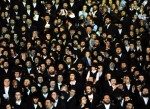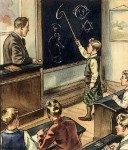 The flip side of “conversion” – non-jews who want to be jews.
The flip side of “conversion” – non-jews who want to be jews.
Jews make changes in order not to be noticed as jews, not to stop being jews. Wannabe jews are non-jews who actually want to change into jews. They believe this is possible based in part on their own misunderstanding of the nature of jewishness, and in part on jewish dishonesty about it.
Non-jews can’t really start being jews any more than jews can stop being jews. In both cases the same biological essence of jewishness stands in the way. At the same time we see that the ideological essence of identity is powerful in its own way.
Non-jews who hold jews in high esteem, with wannabe jews being an extreme example, can still serve the best interests of jews. Those so disposed are in a sense an extended phenotype of jews. While jews cultivate the worship of jews, ideologically speaking, and welcome the benefits the consequent sevice this provides them, they also firmly discourage and resist those who mistake it for an invitation to join them biologically.
Some jews, like Michael Freund and Stanley Hordes, espouse relatively inclusivist notions, but the reality is that jewishness is exclusivist. Jews stereotypically urge their children to marry other jews. “Intermarriage” with non-jews is deplored by those who don’t condemn it outright. Though jews are disdainful of tribemates who “convert”, or otherwise demonstrate disloyalty, their consensus is that nothing a jew says or does stops them from being a jew.
Focusing on jewish attitudes regarding Stanley Hordes and his “Hispanos” highlights, once again, that jewishness is about peoplehood, not relgion or beliefs.
Mistaken Identity? The Case of New Mexico’s “Hidden Jews”, by Barbara Ferry and Debbie Nathan, The Atlantic, Dec 2000:
To make a distinction that will later prove germane, [Hordes] is an Ashkenazi. Ashkenazic Jews trace their ancestry to Northern and Eastern Europe, whereas Sephardic Jews trace theirs to Iberia. Almost all Jews in North America today are Ashkenazim. Before the late nineteenth century the Jews in Latin America were overwhelmingly Sephardim.
He also began spending more and more time promoting his growing belief that Sephardic crypto-Judaism had survived four centuries of secrecy in the Southwest. The proposition, if true, was astonishing. And it held enormous appeal for Jews elsewhere in the United States, still grappling with the legacy of the Holocaust and eager for stories about Jewish survival against all odds.
The jews liked the idea, until they didn’t. As it became increasing clear that a number of very brown “crypto-jews” were eager to “rejoin” the tribe, the jewishness-as-religion-and-culture pretense gave way quickly to the jews-as-hereditary-biological-group reality.
EVEN as Hordes and the Sandovals were riding a wave of celebrity, an undercurrent of trouble was gathering force. The problems had started in 1992, when an Indiana University graduate student named Judith Neulander arrived in New Mexico with notebooks, cassette tapes, and hopes of pursuing her own research in crypto-Jewish studies.
Neulander wanted to be the first folklorist to dignify the claims with ethnographic research. As she derisively puts it now, she wanted to be “Queen of the Crypto-Jews.”
It wasn’t long before she ran across the work of the anthropologist Raphael Patai.
IN the 1940s Patai had visited Venta Prieta, a dusty town near Mexico City, where people have been calling themselves Jews at least since the 1930s. When Patai arrived, on the heels of World War II, the Venta Prietans actually had a synagogue. Their prayers sometimes included a few sentences in halting Hebrew. In the spring they celebrated Passover, with a seder and flatbread. With their short stature, black hair, and dark skin, the Venta Prietans were indistinguishable from the mestizo Catholic population that dominates Mexico. Yet they claimed descent from one of the country’s Inquisition-era Sephardic families, the Carvajals, and said that their religion was handed down over the centuries from them.
As Patai poked through Venta Prieta’s history, he accumulated persuasive evidence that its people were not descended from Jews at all. Instead they were the inheritors of what might be called crypto-Protestantism. In the early decades of this century, it seems, a fundamentalist splinter group called the Church of God Israelite left Mexico City to proselytize elsewhere; some settled in Venta Prieta. The group was a branch of the Church of God (Seventh Day) — a sect originally located in Iowa, and now headquartered in Colorado. As the name suggests, Church of God (Seventh Day) members observe the sabbath as Jews do, on the last day of the week — Saturday. They ignore Christmas and Easter, believing these holidays to be “pagan.” Branches in the Southwest celebrate their own versions of Rosh Hashanah, Yom Kippur, and Sukkoth, along with Passover, which they mark with a ceremony that includes unleavened bread.
The doctrinal roots of the Church of God (Seventh Day) go back to the Reformation, to an obsession among some Protestants with the Second Coming and the Millennium. One scenario, which is repeated these days by many televangelists, has it that Jesus will not return to earth until all the world’s Jews are gathered together to welcome him back. If present-day Jews are uninterested in doing so, then perhaps they can be replaced by worthier ones, by Jews who accept Christ as the Messiah. These more promising Jews, in the view of some fundamentalist Protestants, disappeared with the ten lost tribes of Israel. Now they must be found, so that the Savior can return.
This logic has engendered a centuries-old preoccupation with identifying certain gentiles as long-lost Jews.
The long discourse on “Hebraic Protestantism” in the middle of the article comes across as an attempt to sow confusion, to disguise what’s really at the heart of all forms of crypto-jewishness – the centuries-old preoccupation jews have with their best interests as a people.
This still reflects the impact and influence jews have, even if only indirectly on the thinking of others.
Fifty years later, Neulander believes, the children and grandchildren of former members are recalling their elders’ Old Testament customs and misinterpreting their last words about being Jews. These recollections, Neulander says, have been skewed by Stanley Hordes and others who are ignorant of the Southwest’s true recent history. It is a history that includes both fundamentalist Protestants and other groups whose behavior could be wrongly construed as crypto-Judaism. Muslims, too, fled the Inquisition, settled in New Spain, eschewed pork, and ignored priests. Sephardic immigrants also came to Mexico and the Southwest from countries such as Morocco and Turkey, where they had practiced Judaism openly for centuries. Jews from Germany and Eastern Europe have been in Mexico and the Southwest for 150 years. They have intermarried with Latinos, and many have even embraced the Catholic Church. They might have kept dreidels in the house, but that is no sign of the Inquisition.
When asked about Neulander, society members often sneer, sometimes without having looked at any of her work. Even those who have done the reading find it easy to despise her. For when Neulander makes her arguments, she presents more than just dry scholarship on Protestantism. She also speculates about the reasons Hispanos might be inventing what she calls an “imaginary crypto-Jewish identity.”
Neulander thinks they are doing it because they are, in effect, racists. Colonial Spaniards were obsessed with proving they had “pure” blood, untainted by that of what they regarded as inferior peoples. The same has been true for many New Mexicans, and Neulander believes that the concern for purity — limpieza de sangre — is intensifying, now that Hispanos are being boxed in by Anglo newcomers and Mexican immigrants. As noted, Hispanos have always been loath to be called Mexicans. But that is how Anglos in the region have identified anyone who speaks Spanish. So, Neulander theorizes, some Hispanos are using crypto-Jewish identity as a postmodern marker for ethnic purity. What better way to be a noble Spaniard than to be Sephardic, since Sephardim almost never marry outside their own narrow ethnic group — and would certainly not intermarry with Native Americans? Neulander also comes at the racism issue from another, not quite compatible angle. She stresses that Protestant lost-tribes logic is deeply anti-Semitic. Below its Judeophilic veneer lies the belief that because they reject Jesus, most of today’s ethnic Jews will in fact go up in flames at the Apocalypse.
Such talk frightens and offends those who call themselves anusim. True, some of them are fixated on finding a noble Spanish past. But some from Hispano families are politically liberal, involved in civil-rights work, and proud of their mestizo complexions and ancestry. They are eager to stir into their Raza Cósmica mixture what they see as the ultimate outsider blood — that of Jews.
In typical jewish fashion, Neulander’s “thinking” inverts reality. Never mind the famous endogamy of crypto-jews – the mestizos are the real “racists” obsessed with purity. And those Protestant wannabe jews? Well, clearly they just hate jews.
“Thinking” like this is about transferring attention and blame elsewhere, to disguise jewish ethnic chauvinism.
Let’s shift our focus now from poor mestizo communities full of wannabe jews to some examples of more or less well-known and well-to-do individual wannabe jews in America.
What Attracted Madonna To Kabbalah?
Madonna was drawn to Kabbalah while she was pregnant in the mid-’90s, and the [Kabbalah Centre] group acknowledges that it wouldn’t have taken off with celebrities if she hadn’t jumped on the trend.
In Can There Be Judaism Without Belief In God? Robert Putnam, author of Bowling Alone, explains:
I’m a Jew by choice—I converted 50 years ago, and I’m even more satisfied with that choice now than I was a half-century ago. That’s partly because being Jewish is mostly not about beliefs, but about connections with other people, sharing values and a collective destiny.
Kol Nidre Helped a Convert Find a Sense of Belonging in the Jewish Community, by Annette Gendler, Tablet Magazine, 12 Sep 2013:
When the cantor sang those first few notes—a sliver of sobbing laced between the high and low notes, invoking centuries of Jewish pleading with God—what had been just another prayer somehow got under my skin and became an experience. There I was, in the sanctuary that is never as full as it is on Yom Kippur, amid all these people wrapped in prayer shawls, all of us standing and listening to the cantor repeating Kol Nidre three times, each time a little louder. As I alternatively looked down at my prayer book and surveyed the crowd, I felt a shiver crawling up my arms, and I thought to myself, “This is what it means to belong to something larger than yourself.”
Luke Ford – most hated Jewish blogger – interviews me, 7 Mar 2010:
Luke Ford is probably the most hated Jewish Blogger, he told me that he has been banned from almost every shul in LA and receives death threats when he walks down the street. Along with the fact that he was called the Matt Drudge of the porn industry, made me kind of excited to be interviewed by him.
Is Luke Ford good for the Jews?, by Brad A. Greenberg, Jewish Journal, 2 Aug 2007:
He is an LA blogger who writes about kinky porn, Orthodox Judaism and sinful politicians. But Luke is a contentious figure in the Jewish community, of which he is a convert into, and is both loved and loathed by people in the porn industry.
This is the only shul that’s let him continue davening there after discovering the depraved world within which he works. Judaism is not about a personal relationship with God, and without an accepting community there is no religious observance. For a convert like Ford, there is no Jewish identity absent Judaism.
“Orthodox Judaism in general, not just going to shul, gives me much needed structure,” Ford says after the service ended. “I have no core. I’m way too flexible on the things I do. This gives me some structure, and it’s important for me to bounce off the same people everyday…. It gives my life meaning, it gives my life rhythm, it gives my day a beginning and end. And it reminds me that there is a God.”
A recent blog post by Ford notes the difference between universalist and particularist morality and the tribal/racial nature of jewishness. Life In A Tribe, 15 Sep 2013:
Growing up a Seventh-Day Adventist among other WASPs, it never occurred to me that it was OK to cheat, steal, abuse outsiders. Sure, some Adventists did it, but there was no widespread belief that such cheating of outsiders and the government was ok. Rather, there was the belief that what belongs to Caesar belongs to Caesar. In Adventism, as I recollect, there was no different moral code for treating those inside and outside the group. I never heard from anyone that it was religiously OK to cheat the government with taxes, etc.
I’ve learned over the past 20 years, however, that the tribal approach to life is different. When you practice Orthodox Judaism, for instance, that tends to limit your social interactions with non-Jews and can easily spill over to dismissing them. The tribal racial approach to life emphasizes your group over outsiders.
Luke Ford Returns To Aish HaTorah (Orthodox Judaism Los Angeles), 10 Jan 2011. OY! So wannabe it hurts. OY!
Wannabe jews see the advantages of jewish collectivism and are attracted to it, hoping to participate. The real jews, for their part, prefer servants over “converts”.
Podcast: Play in new window | Download


















